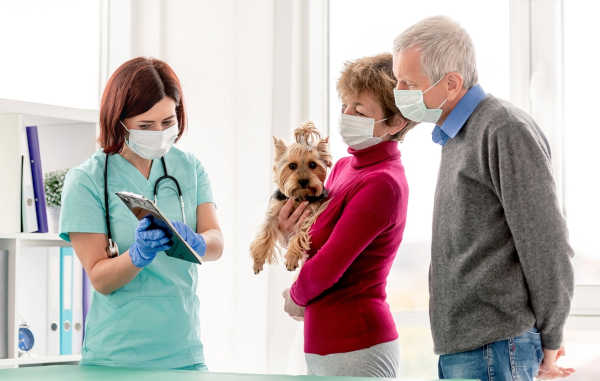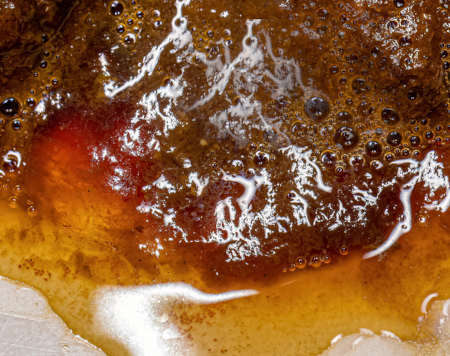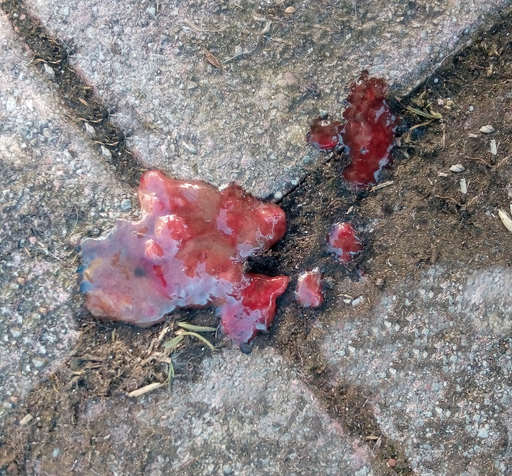
This article was updated on January 31st, 2024
Occasionally when I was in practice, I’d get a visit from concerned owners because they saw blood spots in their dog’s bedding, stools or on their anus. In this article, we’ll look at why dogs bleed from the anus, when you can try to help your dog at home, and when it’s time to head to the vet.
When is it OK to try to help my dog at home?
Many times, you can try helping your dog at home when your dog shows mild symptoms. For example, mild infections and dietary disturbances can often resolve with supportive care.
Additionally, you may be able to provide first aid or home remedies for mild anal gland issues or intestinal parasites. We still recommend that you call your veterinarian to discuss your particular situation based on your dog’s overall health profile.
As long as your dog is acting normal, the bleeding is minimal/intermittent, and he’s still eating and drinking, you’re usually safe to monitor his condition and treat him at home. If you have any doubts, call your vet.
How to get started with helping your dog at home
If you notice bleeding from your dog’s anus:
1. Use Caution
Approach him carefully to get a closer look. If your pup has a recent injury, he may act aggressively out of fear or pain.
2. Check your dog
If possible, ask someone to assist you as you assess your dog
1. Check his respiratory and heart rates
2. Check his gums for a healthy pink color and press lightly to see how quickly the color returns
3. Check his anus and try to determine the source of the bleeding – look for signs of
- Intestinal parasites: visible segments or whole worms near the dog’s anus, which may look like small, moving segments or rice grains. Additionally, dogs might scoot or drag their rear on the ground due to irritation. Check their stool for worms.
- Anal sac swelling or impaction: look for any noticeable swelling or redness near the anus, a foul smell, or if the dog persistently licks or scoots its rear end.
- Injuries or abrasions
- Blood coming from inside the intestinal tract
3. Initiate home care
If the bleeding is minimal or intermittent, apply appropriate remedies to comfort and support your dog. This may include:
1. Fasting your pup for 1-2 days or feeding a bland diet to rest an irritated gut
2. Giving your dog probiotics: dogs experiencing diarrhea or constipation may struggle to empty their anal glands, which can result in an infection or abscess. To prevent this, it’s important to maintain a consistent diet and avoid overfeeding treats. Administering a probiotic like Fortiflora can also help if your dog’s bleeding is due to anal gland issues.
3. Giving your dog plenty of fresh water to maintain hydration
4. Increasing fiber in the diet to increase stool firmness. To promote regular bowel movements and help naturally empty the anal glands, consider adding high-fiber foods like pumpkin, or specially formulated high-fiber dog food to their regular meals.
5. Using remedies/treatment described above for anal glands or intestinal parasites: home remedies for anal glands or home remedies for intestinal parasites or worms.
6. Keep your dog at an appropriate body weight: dogs who are obese are at higher risk for developing anal gland issues (as well as other medical conditions such as arthritis and diabetes).
Frequently asked question from our patients:
Can I use an over-the-counter cream for my dog’s bleeding anus?
Mild over-the-counter creams with zinc or castor oil are generally safe for topical use on your dog’s bleeding anus. You may also be able to use plain Neosporin. However, none of these creams should be ingested. If you choose to apply a cream, watch your dog closely to ensure he does not lick the area. Creams are a temporary measure at best and you should check with your vet first before using any medication.
IMPORTANT: Most remedies are designed to support and comfort your dog but will not cure the disease. With mild conditions, your dog’s immune system may be able to overcome the problem. However, if your dog doesn’t improve in a few days, or if other symptoms arise, contact your veterinarian. There may be an underlying condition that requires attention.
Home remedies, based on the underlying conditions that are causing your dog’s issues
Of course, understanding the root cause of your dog’s issue is essential to treating your dog effectively. In the section below, we have listed the most common conditions that cause anal bleeding in dogs, along with their typical signs and home remedies.
Always check with your veterinarian before starting home remedies as some conditions might be emergencies or might require veterinary treatments:
1. Anal gland disease (Symptoms & home remedies)
One of the most common causes of anal bleeding is anal gland issues. If your dog’s glands don’t discharge properly, they can become impacted. The pressure and inflammation sometimes can cause an abscess or infection. Under these circumstances, the sac may ooze bloody pus.
Anal gland disease is fairly common in canines. The condition can affect any age or breed of dog. Impactions and abscesses are serious conditions. Without treatment, an infection may spread to the body, or an abscess can rupture and cause damage to the anus and rectum.
Signs of anal gland disease include:
- Scooting or dragging the butt across the floor to relieve pressure
- Excessive licking/biting at the tail head or around the anal area
- Clamping the tail down
- Discharge on bedding or other surfaces
- Sensitivity around the butt – some dogs may growl or snap if you touch the area
- Bleeding or pus from the anus
- Characteristic fishy odor
- Straining to defecate, possibly with vocalization
- Swelling around the anus that may be red and feel hot to the touch
Home remedies for anal gland disease: If you notice signs of impacted or swollen anal glands, there may be some things you can try at home. While some people recommend you manually express your dog’s sacs, you should never attempt this without your vet’s direction and approval. Improperly expressing the anal sacs can cause tissue damage.
However, you may be able to comfort your pooch and encourage the natural draining of the anal sacs by:
- Applying warm compresses of water or salt water to the gland openings
- increasing dietary fiber to firm up the stools
- Exercising your dog to stimulate normal bowel movements and opening of the ducts
When your dog’s anal gland disease causes abscesses, infections, or anal bleeding, you should take him to the vet. Depending on the severity of your dog’s condition, the doctor may:
- Lance and drain swollen abscesses
- Drain and flush the anal glands
- Surgically remove the anal sacs
- Prescribe anti-inflammatories or steroids to reduce swelling
- Prescribe antibiotics for infections
2. Dietary issues (Symptoms & home remedies)
Dogs with food intolerance or who eat something their digestive system can’t process may develop an inflammation of the intestines known as colitis. Common symptoms of colitis are:
- Fresh blood in the stool
- Vomiting
- Soft or watery stool
- Straining to poop
- Abdominal pain
- Increased frequency and urgency of bowel movements
Home remedies for dietary issues: If your dog suffers from colitis triggered by food, it’s usually manageable. You can try fasting your pup for 1-2 meals and then feeding him a bland diet like lean chicken and boiled rice to rest the gut. Additionally, supplement the food with probiotics to soothe the gut and help restore normal digestion.
Take your dog to the vet if his symptoms continue for more than 1-2 days. Ongoing bleeding can cause anemia, and repetitive vomiting can cause dehydration. The doctor can examine your pooch and initiate treatment, which may include:
- IV fluids
- Antibiotics to prevent secondary infection
- Changing your dog to a hypoallergenic diet
3. Intestinal parasites (Symptoms & home remedies)
While usually most common in puppies, intestinal parasites can infest any age dog. Our dogs investigate their surroundings with their mouths and may pick up eggs or larvae from the environment. Signs of parasite infestation include:
- Blood in the poop(stool may be formed, soft, or liquid)

- Rubbing or licking at the hind end
- Worms in the poop or around the anus
- Pot-bellied abdomen
- Lethargy
- Vomiting(you may see worms in the vomit)
Home remedies for interestinal parasites: If you suspect that your dog has worms, you can try a few home remedies to remove the parasites (after discussing the situation with your veterinarian):
- Pumpkin seeds – ground pumpkin seeds contain the amino acid cucurbitacin, a natural anthelmintic, which can paralyze roundworms and tapeworms. As a result, the worms can’t attach to the intestines and are pooped out.
- Diatomaceous earth – Food-grade diatomaceous earth is generally harmless to your dog but contains microscopic fossils that can damage the worm’s exoskeleton and cause it to dry out or die.
- Chopped carrots – Coarsely-chopped carrots may help to dislodge intestinal parasites from the digestive tract so that your dog poops them out. They’re also a nutritious treat most dogs enjoy.
These measures aren’t always successful, and some remedies can be dangerous if you give too much or apply them wrongly. Talk to your veterinarian before attempting natural approaches, and seek medical treatment if:
- Your dog doesn’t improve in a 1-2 weeks
- Your dog has repeated vomiting and diarrhea
- Your dog becomes dehydrated
- Your dog stops eating
- Your dog becomes weak or lethargic
For severe infestations or cases that don’t respond to home remedies, bring a stool sample to your veterinarian. Leaving parasites untreated in your dog can lead to anemia from blood loss, blockages, or other conditions. The doctor can examine your dog’s feces and prescribe a deworming agent to eliminate the worms.
4. Infections (Symptoms & home remedies)
Your dog can have bloody stools or diarrhea with certain viral or bacterial infections like Salmonella or parvovirus. Signs of infection may include:
- Red blood on the surface of the poop
- Formed or soft/runny stools
- Straining to defecate
- Increased number of bowel movements
- Vomiting
- Loss of appetite
- Lethargy
- Fever
- Abdominal discomfort
Home remedies for infections: When infections are very mild, your dog may be able to overcome them. Provide supportive care to help your dog:
- Fast your dog for a day
- Offer a bland diet such as boiled rice and lean chicken
- Supplement the food with probiotics to restore digestive health
- Provide free choice drinking water
Seek veterinary treatment when symptoms won’t resolve in a few days, or if your dog has
- Uncontrolled vomiting and diarrhea
- Weakness or depression
- Anorexia
- Pale gums
- Dehydration
Your veterinarian will complete an examination and run diagnostic tests to determine the cause of the bleeding. Treatment may include:
- IV fluids
- Antibiotics
- Antiemetic drugs
- Antidiarrheal drugs
5. Hemorrhagic gastroenteritis
The cause of hemorrhagic gastroenteritis (HGE) has not been identified yet. When dogs develop HGE, it usually starts suddenly and may include symptoms like:

- Vomiting
- Abdominal pain
- Lethargy
- Loss of appetite
- Fever
Dogs with HGE lose fluids and electrolytes rapidly, and they can die without supportive veterinary care. With a physical examination and diagnostic tests, the doctor will rule out other causes and make a presumptive diagnosis. Treatment usually includes;
- IV fluids that include potassium and electrolytes
- Antibiotics to counteract secondary infections
- 24-hour fast followed by a bland diet
- Pain medications
- Gastroprotective drugs like sucralfate
- Antiemetic drugs
- Probiotics to restore healthy gut flora
When should I seek veterinary care for my dog’s bleeding anus?
When your dog starts bleeding from the anus, it’s not always a veterinary emergency. By checking your dog’s vital signs and trying to determine the nature, amount, and source of the bleeding, you can determine whether it’s time to head to the vet or if you start with at-home treatment.
However, you should take your dog to the vet if:
- The bleeding doesn’t clear up in a few days
- There’s bloody diarrhea
- The stool is black and tarry
- Your dog is vomiting
- Your dog refuses to eat
- Your dog is lethargic, weak, or depressed
- The anal glands are swollen and oozing blood and pus
- Your dog has pale gums
Disclaimer: This website's content is not a substitute for veterinary care. Always consult with your veterinarian for healthcare decisions. Read More.


Be the first to comment